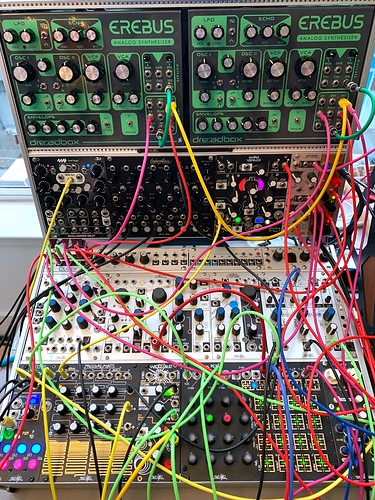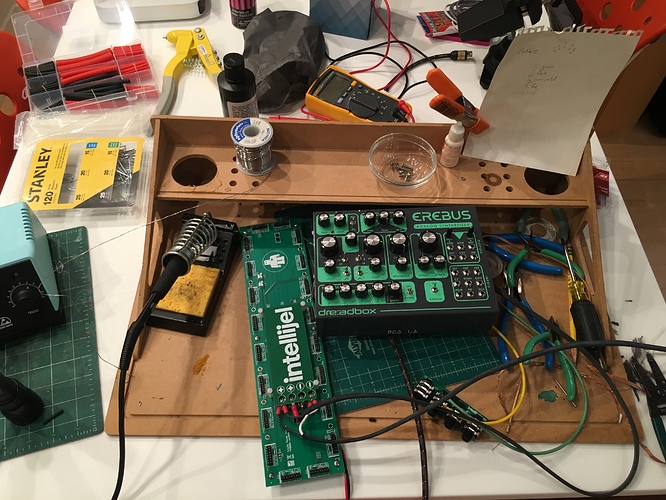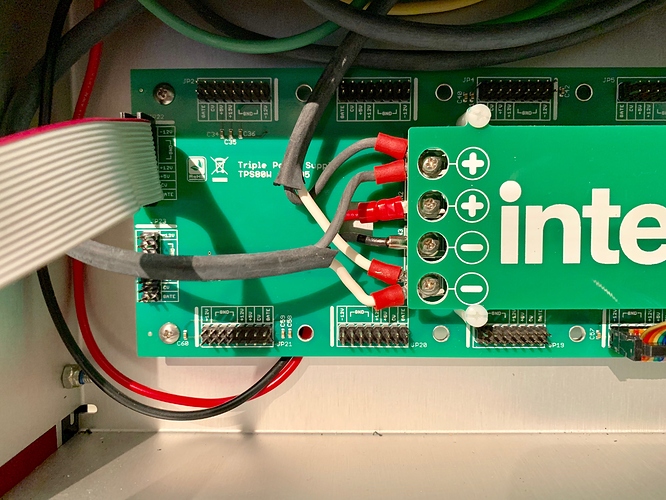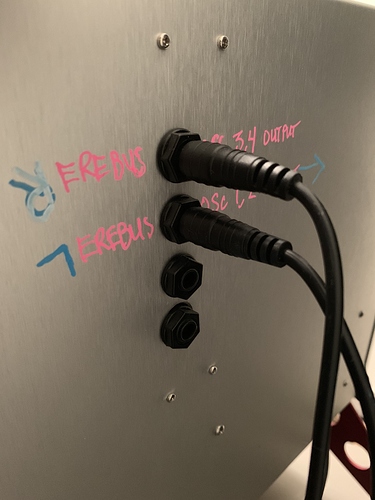+1 for ADAT.
thunderbolts / firewire standards comes and goes (and - as you said - it’s hard to run multiple audio devices in sync)
+1 for a 1u plog!
Also liked the suggestions of an lpg and a compressor
Octave 1U would be bonkers awesome!
+1 for ADAT…
Would love to see options for 96kHz and up to 16 channels… backside of module interconnects to expand ports would be awesome!
But 48kHz x 8 channels w/ option for two interconnected for 16 channels would be awesome!
so youre thinking the module has 8 output jacks and 2 optical adat ports, but can link with a second one to increase fidelity or channels? i like that
@damase I wasn’t thinking exactly that, but I like the idea!
I have a Saffire Pro 40 (firewire) audio interface at the moment. I use a conversion black box to convert to USB C on new Macbook Pro.
I’ve been digging around and looking at ADAT specs and audio interface specs. If I go the 96kHz / 24bit route w/ my interface I can only get 4 channels via ADAT. So I’m hamstrung by my audio interface at the moment. If I go 48kHz / 24bit I can get 8 channels. This seems to be somewhat “standard” for many interfaces out there.
I have a 104HP Intellijel skiff and I’ll soon start building the second. I have a Doepfer 4 channel mixer at present and I mix down to stereo and out the Intellijel I/O 1U. I’m constantly using all 4 channels and having to use a second mixer to mix two or three channel into one before going into the Doepfer mixer… It all gets a bit muddled and confusing and I’m constantly finding when I listen to the stereo recording I’d like to be able to control each voice independently in post, mostly volume, but also to be able to throw on a plugin or two independently.
Ideally I’d love to have the ability to send 16 tracks @ 96kHz / 24bit. That would more than cover the second skiff voices and leave room for future. But that would certainly mean upgrading the audio interface.
8 tracks seems like my minimum threshold at the moment. I’m easily getting up to 6 tracks now, certainly more with another skiff. But even then I’d need a new audio interface if recording at 96kHz b/c I of the 4 channel maximum (unless I start using physical inputs). I could also fall back to 48kHz for now, and get my 8 tracks…
I haven’t researched, but I wonder how many interfaces have dual (or more) ADAT inputs?
But your idea is great… 8x 1/8" outputs on each module w/ 2x ADAT outs… Then you could run one ADAT port for 8 channels @ 48kHz and 2x ADAT for 96kHz… And if you could daisy chain the modules internally, you get 16 out @96kHz (assuming your interface has enough inputs/ports on the receive end, or multiple interfaces).
This isn’t even thinking about any ADAT inputs… If you wanted to go the other way.
I’d really want to see considerations in design for those looking for higher bitrate recordings.
I may be off base on some of these details, it all gets a bit nebulous… I’d love to hear other thoughts/ideas…
PS: I just ordered 8x 1/8" to 1/4" mono shielded patch cables. I’m going to give that a shot w/ the physical inputs on my interface @ 96kHz and see how I fare for the time being…
the sample rate/channel constraint is not unique to your interface, thats just the way adat is…
2 channels at 192k
4 at 96k
8 at 48k
i think bit depth is still dependant on your interface, but i could be wrong.
there are interfaces that offer more adat inputs, mine has 2 in and 2 out for example.
The Expert Sleepers ES-3 / ES-6 is an ADAT interface also, but it seems to be more focused on streaming CV from Silent Way to the modular. Its capable of audio as well, but for 8 inputs youre lookin at about 16 HP and a fair amount of money as well.
Another concern for me in the whole situation is the A/D converters… because i believe they make a big difference in sound quality. If your interface is a solid master clock it will make a huge difference but you are still leaning on the A/D converters of the module(theoretical intellijel 1u adat output module).
Yeah I’ve been looking at Expert Sleepers…
ES-3 + ES-6 (6 channel ADAT in) + ES-7 expander (last 2 channels)… Plus burning all the HP, seems a less than elegant solution, not to mention ~$500ish cost. And you’re still only at 4 channels @ 96kHz…
I was also looking at the Befaco Hexmix + Hexpander:
https://www.befaco.org/en/hexmix/
That gives you 6x physical outputs w/ 1/4" jacks… But around $1000ish… AND a TON of HP eaten up… And more possible noise issues w/ cabling.
That’s why I’m just relocating my audio interface right next to the modular now and running 1/8" to 1/4" cables to the 8 physical inputs for the short term… Should be able to get 8x @ 96kHz…
The only problem might be noise issues which Scott @ Intellijel has been warning me about in support messages. I’m going to try it straight to the interface, but he’s suggesting I put a VCA, buffered mult or some other powered module as the last step in the chain to decouple the signal and help avoid noise issues.
It doesn’t seem there is a really clean solution for this out there… Why can’t I just be happy w/ stereo??? hahaha…
The buff module was only necessary for your query regarding the Octalink to connect cases. Going straight from a VCA to your interface with a short cable run should be fine.
@ScottMFR Thanks for clarification…Yeah, I just decided to relocate the interface closer and hopefully eliminate potential problems…
For clarification to others, I was planning on using the Octalink and a long ethernet cable (10-20’) over to a remote audio interface and then go octalink 1/8" to 1/4" to plug into the interface… Which led me down the rabbit hole of ADAT conversations and then here… 
at the risk of side tracking this thread further, ill just conclude by saying that direct analog outputs are great but you still need preamps and A/D stage anyway, which for me im already using all of mine so thats why ADAT would be great
8 channels at 48k, is perfect for each 1U module. As mentioned, these could be daisy changed to provide another 8 channels.
In all my years of studio engineering, 24bit, 48K is the sufficient.
Anyways, the idea of this module was just something I feel many people could utilize with their 1U Intellijel systems. I’ll leave it in the hands of the Intellijel boys to further discuss.
I know this has been brought up a couple of times in the past but now that I am setting up my 104hp black case, I must say that I really would love me some 1u modules with black panels… 
That 1U row really feels more like part of the case than a row of modules, so black seems like a natural.
To the folks at Intellijel - any thoughts on the likelihood of such a thing?
A 1U gate delay module, similar to the gate delay section on a Roland 572, would be great. I have no idea if it would be possible though.
Just got a second 104HP 7U case and would be super stoked for a stereo out 1U (without the ins) that connects to the case jacks. Would be stellar to use the Pedal I/O on one pair of jacks and a Stereo Out on the other. Saw a thread a ways back requesting this and just wanted to reactivate this request in the thread. Keep up the great work, fam! <3
We are definitely considering it when we get a bit more time…
A stereo out 1U module would also open up the possibility of having 4 outs from your system! That with Planar for quadraphonic panning would be damn cool…
Exactly! Right on!
Sorry it took me so long to reply, I just noticed this. Here are some photos.
The first step was to pop out the rail separating the 1U space from the 3U space. The Erebus fits perfectly in this opening.
I wired the Erebus’ power to the spare 15v posts on the Intellijel power supply. I also wired the Erebus’ audio out to the Intellijel output jacks, but I had to relocate them to the back of the 7U case, as there wasn’t enough clearance to insert the Erebus synths into the case without doing major Erebus surgery. I wanted this mod to be as reversible as possible.
I had to use spacers like the brass ones in the picture to offset the synths from the back of the case. They are actually screwed in through the case back. You can see the screws in the shot showing the relocated audio outs.
Here’s a little video of it in action:




